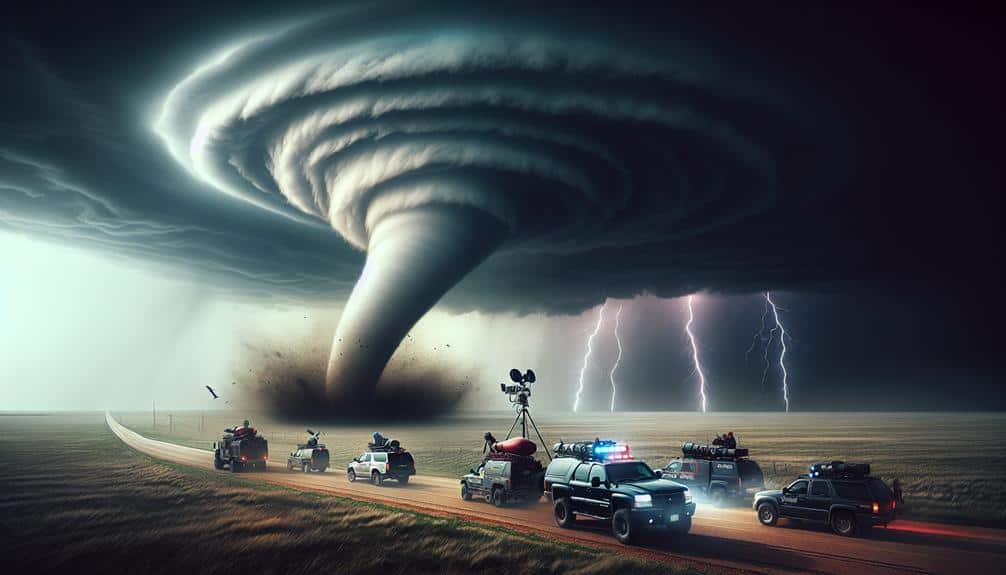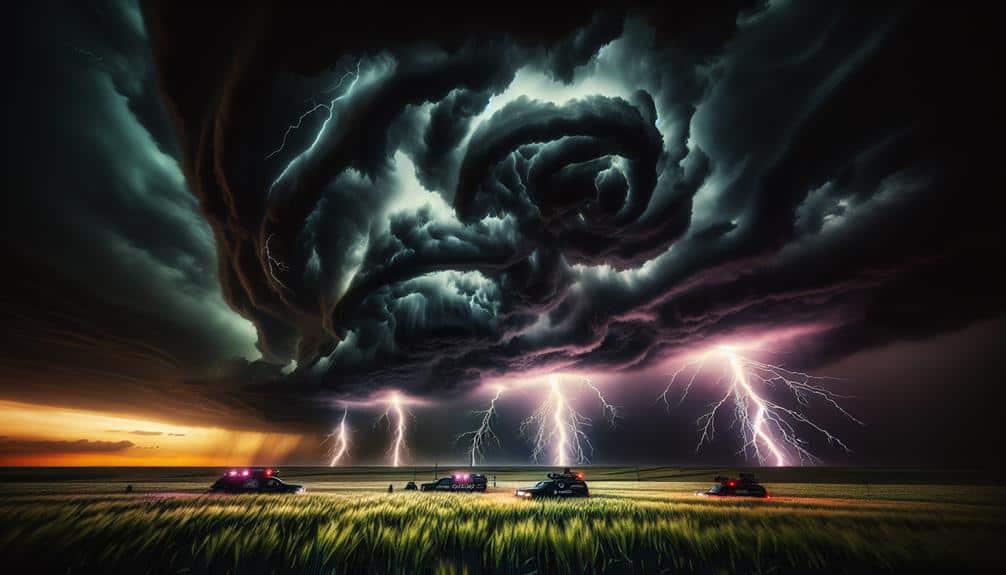We attribute the greater success of some storm chasers to utilizing advanced meteorological tools like Doppler radar and satellite imaging, which enhance storm prediction and tracking capabilities. Coupled with extensive training and field experience, these chasers can interpret intricate weather models accurately. Real-time data analysis, using high-resolution radar systems and GPS tracking, guarantees precise and swift situational awareness. Effective team coordination, involving strategic positioning and clear communication, further optimizes their operations. Thorough risk management strategies, including regular risk assessments and safety protocols, mitigate hazards. Those interested might uncover more detailed aspects of storm chasing methodologies and technologies.
Key Points
- Advanced Technology Utilization: They leverage cutting-edge tools like Doppler radar and satellite imaging for precise storm tracking and prediction.
- Field Experience: Accumulated practical experience in storm chasing enhances situational awareness and decision-making.
- Strong Forecasting Skills: Expertise in interpreting weather models allows for accurate storm path predictions.
- Effective Team Coordination: Strategic positioning and role specialization improve operational efficiency and data collection.
Advanced Meteorological Tools
Advanced meteorological tools, including Doppler radar and satellite imaging, enable us to accurately predict storm patterns and trajectories. These technologies are pivotal for storm chasers, providing the data necessary to make informed decisions in real time.
Doppler radar, in particular, measures the velocity of precipitation particles, allowing us to detect rotation within thunderstorms. This capability is critical for identifying supercells, which have the potential to spawn tornadoes.
Satellite imaging complements Doppler radar by offering a broader view of atmospheric conditions. High-resolution images from geostationary satellites provide continuous monitoring of cloud development, temperature, and moisture levels. This remote sensing capability gives us the ability to track storms over large distances and identify potential areas of severe weather.
Experience and Training
Effective storm chasing hinges on the extensive experience and rigorous training of the chasers, who must interpret meteorological data and execute strategic maneuvers under high-stress conditions. Our success isn't just about cutting-edge technology; it heavily relies on our field knowledge and forecasting skills. Practical experience and a solid educational background form the bedrock of effective storm chasing.
A thorough understanding of atmospheric dynamics, coupled with hands-on training, allows us to predict storm behavior accurately. Our ability to read complex weather patterns and make split-second decisions directly impacts our success rates. The more seasoned chasers among us have honed these skills over years of practice, learning from every storm we encounter.
Key factors contributing to successful storm chasing include:
- Field Knowledge: Deep understanding of meteorological principles and storm structures.
- Forecasting Skills: Ability to interpret weather models and predict storm paths.
Our educational background often includes degrees in meteorology or related fields, ensuring we've a strong theoretical foundation. This blend of practical experience and academic training enables us to navigate the unpredictability of severe weather efficiently, making our operations not just successful but also safer.
Real-time Data Analysis
Real-time data analysis is the linchpin of our storm-chasing strategy, allowing us to make rapid, informed decisions in the field. By integrating cutting-edge technology, we guarantee our data accuracy remains uncompromised. High-resolution radar systems, GPS tracking, and mobile weather stations provide us with the granular details needed to anticipate storm movements and behavior.
We rely heavily on technology integration to synthesize vast amounts of meteorological data swiftly. Tools like Doppler radar and satellite imagery feed us continuous updates, minimizing the lag between data collection and actionable insights. This immediacy is essential; a delay of even a few minutes can be the difference between capturing groundbreaking footage and missing the storm entirely.
Our approach prioritizes data accuracy above all else. We cross-reference multiple data sources—public weather services, proprietary models, and on-the-ground observations—to verify the reliability of our information. This multi-layered verification process enhances our confidence in the data, empowering us to make bold decisions with a high degree of certainty.
Team Coordination
Seamless team coordination is crucial for maximizing our efficiency and guaranteeing safety during storm-chasing missions. Our success relies on strategic positioning and effective communication, which allows us to adapt quickly to rapidly changing weather conditions.
By leveraging our collective expertise, we can make real-time decisions that optimize our chances of capturing valuable data and imagery.
Effective team coordination involves:
- Strategic Positioning: We analyze meteorological data to determine the best locations for observing storm development. This necessitates precise calculations and the ability to predict storm paths accurately.
- Effective Communication: Clear and concise communication is essential. We use radio systems, satellite phones, and digital communication platforms to relay information swiftly and accurately among team members.
We constantly refine our coordination protocols based on post-chase analyses. By examining our previous missions, we can identify strengths and areas for improvement. This iterative process guarantees that we remain agile and prepared for future storm-chasing endeavors, ultimately enhancing our operational effectiveness and safety.
Risk Management Strategies

We prioritize risk management strategies that mitigate potential hazards and safeguard our team remains secure and efficient during storm-chasing missions. By adhering to rigorous safety protocols, we reduce exposure to life-threatening situations. For instance, deploying GPS tracking systems guarantees real-time location updates, enhancing situational awareness and facilitating swift evacuation if necessary.
Our decision-making strategies are driven by both empirical data and real-time analytics. We utilize advanced meteorological models and radar technology to predict storm trajectories with high accuracy. This enables us to position ourselves strategically while avoiding the storm's most dangerous paths. Moreover, each team member undergoes extensive training on emergency response, ensuring preparedness for any scenario.
We also conduct regular risk assessments to evaluate potential threats and adapt our strategies accordingly. For example, we analyze past storm data to identify patterns and refine our approach. By maintaining a dynamic risk management framework, we balance the thrill of storm chasing with the imperative of safety.
In essence, our success hinges on a meticulous blend of safety protocols and informed decision-making strategies. This approach not only safeguards our team but also maximizes the efficacy and impact of our storm-chasing endeavors.
Frequently Asked Questions
What Motivates People to Become Storm Chasers?
We're motivated by the risk vs. reward, the adrenaline rush, the weather obsession, and the thrill seeking. We analyze data, chase storms, and seek freedom in the unpredictability of nature's most powerful events. It's exhilarating and rewarding.
How Do Storm Chasers Manage Their Mental Health During High-Stress Situations?
We employ various coping strategies for mental health, focusing on self-care and stress management. Techniques include mindfulness exercises, physical fitness, and regular debrief sessions, which greatly enhance our ability to handle high-stress storm-chasing situations effectively.
What Are the Environmental Impacts of Storm Chasing?
We should consider storm chasing's environmental impacts, focusing on wildlife preservation and climate change. Data shows increased vehicle emissions and habitat disruption, highlighting the need for sustainable practices to balance research and environmental conservation.
How Do Storm Chasers Fund Their Expeditions?
We don't just rely on the wind; we harness sponsorship opportunities and launch crowdfunding campaigns. Effective budget planning and managing equipment costs guarantee our adventures are financially sustainable while we chase the ultimate freedom nature provides.
Are There Any Regulations Governing Storm Chasing Activities?
Regarding regulations, storm chasing activities are largely self-regulated, but safety measures are paramount. We implement protocols like GPS tracking and communication systems, ensuring our operations align with best practices while maintaining the freedom to pursue data.


